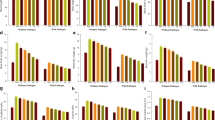Abstract
The goals of the present study were to determine ifCylindrocarpon olidum var.olidum exerts antibiotic activity on teliospore germination ofTilletia laevis in vitro and to evaluate the efficacy of a seed treatment with this antagonist against artificial seedborne infection in the field under natural cropping conditions. Germination of bunt teliospores was completely inhibitedin vitro on water agar medium supplemented with the antagonist’s culture filtrate. In field experiments seed application reduced the incidence of common bunt from 82.9% to 40.4%, and from 81.4% to 42.0% in 1995/1996 and 1997/1998, respectively.C. olidum var.olidum may have a potential againstT. laevis and is worthy of further research on its use as a biocontrol agent for common bunt.
Similar content being viewed by others
References
Agrios, G.N. (1988) Plant Pathology. Academic Press, London, UK.
Becker, J. and Weltzien, H.C. (1993) Bekämpfung des Weizensteinbrandes (Tilletia caries (D.C.) Tul. & C.Tul.) mit organischen Nährstoffen.Z. PflanzenKr. PflanzenSchutz 100:49–57.
Borgen, A. and Davanlou, M. (2000) Biological control of common bunt in organic agriculture.J. Crop Prod. 3: 159–174.
Borgen, A. and Kristensen, L. (2001) Use of mustard flour and milk powder to control common bunt (Tilletia tritici) in wheat and stem smut (Urocystis occulta) in rye in organic agriculture.Proc. BCPC Symposium 2000, Seed Treatment: Challenges and Opportunities (Birmingham, UK), pp. 141–150.
Borgen, A. and Nielsen, B.J. (2001) Effects of acetic acid in control of seed borne diseases.Proc. BCPC Symposium 2000, Seed Treatment: Challenges and Opportunities (Birmingham, UK), pp. 135–140.
Cook, R.J. and Baker, K.F. (1983) The Nature and Practice of Biological Control of Plant Pathogens. American Phytopathological Society, St. Paul, MN, USA.
El-Naimi, M., Toubia-Rahme, H. and Mamluk, O.F. (2000) Organic seed-treatment as a substitute for chemical seed-treatment to control common bunt of wheat.Eur. J. Plant Pathol. 106:433–437.
Elsherif, M. and Grossmann, F. (1991) Versuche zur biologischen Bekämpfung einiger pathogenen Pilze durch fluoreszierende Pseudomonaden unter Anwendung verschiedenen Applikationsverfahren.Z. PflanzenKr. PflanzenSchutz 98:236–249.
Hoffmann, J.A. (1982) Bunt of wheat.Plant Dis. 66:979–986.
Hökeberg, M., Gerhardson, B. and Johnson, L. (1997) Biological control of cereal seedborne diseases by seed bacterization with greenhouse-selected bacteria.Eur. J. Plant Pathol. 103:25–33.
Johnsson, L. (1990) Survival of common bunt (Tilletia caries (DC) Tul.) in soil and manure.Z. PflanzenKr. PflanzenSchutz 97:502–507.
Johnsson, L., Hökeberg, M. and Gerhardson, B. (1998) Performance of thePseudomonas chlororaphis biocontrol agent MA 342 against cereal seed-borne diseases in field experiments.Eur. J. Plant Pathol. 104:701–711.
Knudsen, I.M.B., Hockenhull, J., Jensen, D.F., Gerhardson, B., Hökeberg, M., Tahvonen, R.et al. (1997) Selection of biological control agents for controlling soil and seedborne diseases in the field.Eur. J. Plant Pathol. 103:775–784.
Kollmorgen, J.F. and Jones, L.C. (1975) The effects of soil-borne micro-organisms on the germination of chlamydospores ofTilletia caries andT. foetida.Soil Biol. Biochem. 7:407–410.
McManus, P.S., Ravenscroft, A.V. and Fulbright, D.W. (1993) Inhibition ofTilletia laevis teliospore germination and suppression of common bunt of wheat byPseudomonas fluorescens 2–79.Plant Dis. 77:1012–1015.
Quaghebeur, K., Coosemans, J., Toppet, S. and Compernolle, F. (1994) Cannabiorci-and 8-chlorocannabiorci chromenic acid as fungal antagonists fromCylindrocarpon olidum.Phytochemistry 37:159–161.
Saydam, C., Copcu, M. and Ögüt, M. (1972) Effects of some chemicals againstTilletia foetida (Wallr.) Liro in vitro.J. Turk. Phytopathol. 1:108–114.
Turhan, G. (1994)Cylindrocarpon olidum (Wollenw.) Wollenw. var.olidum als starker Antagonist gegen Pilze und ein neuer Kandidat für die biologische Bekämpfung.Mitt. Biol. BundesAnst. Land- Forstwirtsch. 301:356.
Weller, D.M. and Cook, R.J. (1983) Suppression of take-all of wheat by seed treatments with fluorescent pseudomonads.Phytopathology 73:463–469.
Winter, W., Rogger, C., Bänziger, I., Krebs, H., Rüegger, A., Frei, P.et al. (1997) Weizenstinkbrand: Bekämpfung mit Magermilchpulver.Agrarforschung 4:153–156.
Author information
Authors and Affiliations
Corresponding author
Additional information
http://www.phytoparasitica.org posting July 14, 2005.
Rights and permissions
About this article
Cite this article
Yolageldi, L., Turhan, G. Effect of biological seed treatment withCylindrocarpon olidum var.olidum on control of common bunt (Tilletia laevis) of wheat. Phytoparasitica 33, 327–333 (2005). https://doi.org/10.1007/BF02981298
Received:
Accepted:
Issue Date:
DOI: https://doi.org/10.1007/BF02981298




